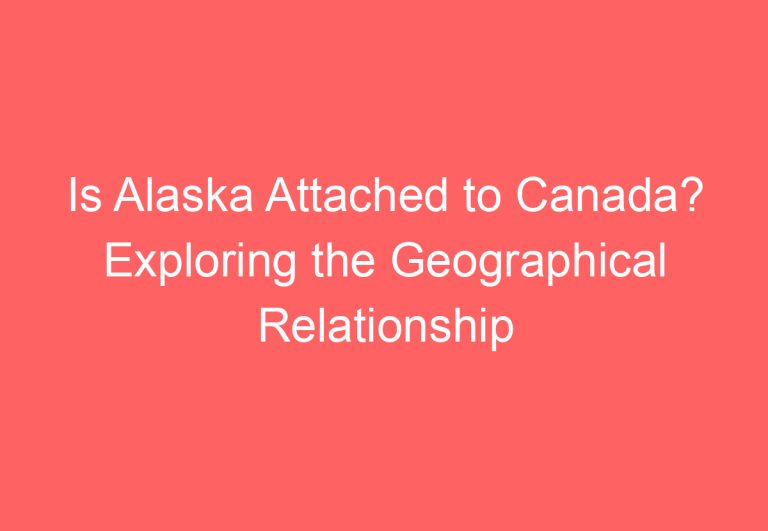Does Alaska Touch the US? Explained
Alaska is known for its stunning natural beauty, rugged terrain, and unique wildlife. As the largest state in the United States, it is also a popular destination for adventurers and outdoor enthusiasts. However, many people wonder if Alaska touches the US, or if it is a separate country altogether.

The answer is that Alaska is a state of the United States and is located on the northwestern tip of North America. It does not share a land border with any other US state, but it does share a land border with parts of Canada. In fact, Alaska shares a long border with Canada, stretching over 1,538 miles from the Yukon Territory in the east to British Columbia in the south.
Alaska is also unique in that it is the only state in the US that borders three different seas: the Arctic Ocean to the north, the Pacific Ocean to the south and west, and the Bering Sea to the west. Despite its remote location and harsh climate, Alaska is an important part of the United States and is home to a diverse population of people and wildlife.
Geography and Location of Alaska

Alaska’s Position in North America
Alaska is the largest state in the United States, located in the extreme northwest corner of North America. It is the westernmost and northernmost state in the country, and its position makes it a unique and important location in the world. Alaska is situated in the eastern hemisphere, and it is separated from the rest of the United States by Canada.
Borders and Maritime Boundaries
Alaska is bordered by Canada on the east, and it shares maritime borders with Russia to the west. The Bering Strait, which separates Alaska from Russia, is only about 55 miles wide at its narrowest point. The Aleutian Islands, which stretch westward from Alaska towards Russia, form a chain of volcanic islands that mark the boundary between the Pacific Ocean and the Bering Sea.
Unique Geographical Features
Alaska has a diverse geography that includes mountains, glaciers, forests, tundra, and coastline. It has more ocean coastline than all of the other U.S. states combined. The Gulf of Alaska, which is located in the southeastern part of the state, is a large body of water that is surrounded by the Alaska Peninsula and the mainland of Alaska.
The state is also home to many unique geographical features, including the highest peak in North America, Denali (formerly known as Mount McKinley), which stands at 20,310 feet tall. Alaska is also home to the Aleutian Islands, which stretch for more than 1,200 miles and are home to a diverse range of wildlife, including sea otters, whales, and seabirds.
In addition, Alaska is located across the International Date Line, which means that it is the only state in the United States that is in both the eastern and western hemispheres. The state is also home to two small islands, Little Diomede Island and Big Diomede Island, which are located in the Bering Strait and are separated by the International Date Line.
Overall, Alaska’s unique location and geography make it an important and fascinating place to explore and study.
Alaska’s Relationship with the US and Other Regions

Alaska is a state of the United States, but it is not part of the contiguous U.S. It is situated in the far northwest of the continent, separated from the rest of the country by Canada. It is the largest state in the U.S. and is sparsely populated. Alaska has a unique relationship with the United States due to its history and geography.
Historical Context and Statehood
Alaska was originally inhabited by indigenous peoples, including the Aleut and Inuit. The area was later explored by Russian fur traders in the 18th century. In 1867, the Russian Empire sold Alaska to the United States for $7.2 million. It became a territory of the U.S. in 1912 and was granted statehood in 1959.
Economic and Cultural Ties
Alaska has a diverse economy that includes fishing, mining, oil and gas production, and tourism. It is home to a number of indigenous cultures, including the Aleut, Inupiat, and Yupik peoples. The state’s population is concentrated in a few urban areas, including Anchorage and Fairbanks.
Alaska has strong economic and cultural ties with both the United States and Russia. The state’s proximity to Russia has led to increased trade and cultural exchange between the two regions. Alaska also has a large military presence, with several U.S. military bases located in the state.
Transportation and Accessibility
Due to its location and geography, Alaska is not easily accessible by road or rail. The state relies heavily on air and sea transportation for both passengers and goods. The Alaska Marine Highway provides ferry service between communities along the coast, while several airlines offer flights to and from major cities in the U.S. and Canada.
Overall, Alaska’s relationship with the United States and other regions is complex and multifaceted. Its unique history, geography, and culture have shaped its relationship with the rest of the world. Despite its distance from the contiguous U.S., Alaska remains an important part of the country and a vital contributor to its economy and culture.
Frequently Asked Questions

Is Alaska connected to the continental United States by land?
No, Alaska is not connected to the continental United States by land. It is separated from the other 48 states by Canada, and it shares a maritime border with Russia across the Bering Strait. As a result, Alaska is one of two US states that are not bordered by another state, the other state being Hawaii.
What separates Alaska from the contiguous United States?
Canada separates Alaska from the contiguous United States. Alaska shares a border with the Canadian provinces of British Columbia and Yukon.
How can you travel between Alaska and the lower 48 states?
There are a few ways to travel between Alaska and the lower 48 states. One way is to fly. Alaska has several major airports, including Ted Stevens Anchorage International Airport, which offers direct flights to several cities in the lower 48 states. Another way to travel is by ferry. The Alaska Marine Highway System operates a network of ferry routes that connect Alaska’s coastal communities with ports in Washington State and British Columbia.
What are the geographical boundaries of Alaska?
Alaska’s geographical boundaries are the Arctic Ocean to the north, the Pacific Ocean to the south and southwest, the Bering Sea and Bering Strait to the west, and Canada’s Yukon Territory and British Columbia to the east.
Which countries are in close proximity to Alaska?
Russia is the country that is closest to Alaska. It shares a maritime border with Alaska across the Bering Strait. Canada is also in close proximity to Alaska, as it shares a land border with the state.
What is the significance of the Bering Strait in relation to Alaska’s location?
The Bering Strait is significant in relation to Alaska’s location because it separates Alaska from Russia. It is also the narrowest point between Asia and North America, and it has been an important area for human migration and cultural exchange for thousands of years.






